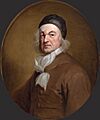Charles de Saint-Évremond facts for kids
Charles de Saint-Évremond (born April 1, 1613 – died September 9, 1703) was a French soldier, writer, and literary critic. He had to live in exile, mostly in England, because he criticized French government policies. He is buried in Poets' Corner in Westminster Abbey.
He wrote mostly for his friends. He didn't plan for his writings to be published. But some of his works were shared during his life. The first full collection of his writings was published in London in 1705, after he had passed away.
Contents
His Early Life and Military Career
Charles de Saint-Évremond was born in Saint-Denis-le-Guast, a town near Coutances in Normandy, France. This was where his family lived.
As a young student, he studied with the Jesuits at a school in Paris. Later, he went to a college in Caen. For a short time, he also studied law in Paris. However, he soon decided to join the army.
In 1629, he traveled to Italy with Marshal Bassompierre. He fought in much of the Thirty Years' War. He showed bravery at the siege of Landrecies in 1637. Because of his actions, he was promoted to captain. During his time as a soldier, he also found time to study. He read the works of Montaigne and learned Spanish and Italian.
Serving Important Leaders
In 1639, he met Gassendi in Paris and became one of his students. Saint-Évremond was present at several important battles, including Rocroi and Nördlingen.
For a while, he worked closely with Prince Condé. However, he made a joke that offended the prince. Because of this, he lost his position in the prince's guards in 1648.
During a civil war in France called the Fronde, Saint-Évremond strongly supported the king. He continued his military career and reached the rank of maréchal de camp.
Exile in England
In 1661, Saint-Évremond faced trouble. A letter he wrote, which criticized a peace treaty, was found by government agents. This led to his downfall.
He had to leave France and went to the Netherlands and then to England. In England, King Charles II welcomed him kindly and gave him a pension.
Later, when King James II left England for France, Saint-Évremond was invited to return to his home country. But he chose to stay in England.
In 1670, Hortense Mancini came to England. She was a niece of Cardinal Mazarin and was known for being charming. She started a social gathering place, or salon, where people would meet for games and clever conversations. Saint-Évremond spent many years enjoying this salon.
He passed away at the age of ninety on September 9, 1703. He was buried in Westminster Abbey, a famous church in London. His monument is in Poets' Corner, a special part of the abbey where many famous writers are honored.
His Writings

Charles de Saint-Évremond never gave permission for any of his works to be printed while he was alive. However, an unauthorized collection of his writings was published in 1668.
Before he died, he allowed Pierre des Maizeaux to publish his works after his death. These were published in London in 1705 and were reprinted many times.
One of his most famous and clever works is called Conversation du maréchal d'Hocquincourt avec le père Canaye. This piece is often compared to the famous Lettres provinciales by another French writer.
His collected works, titled Œuvres meslées, were put together from his handwritten notes. They were printed in London in 1705. His letters with Ninon de l'Enclos, who was a close friend, were published in 1752. He also wrote a play called La Comédie des académistes in 1643, which was printed in 1650.
Some of his other plays include Politick Would-be, which was inspired by a character from Ben Jonson's play Volpone.
Images for kids
-
Portrait of Charles de Saint-Évremond by Godfrey Kneller. c. 1680s
See also
 In Spanish: Charles de Saint-Évremond para niños
In Spanish: Charles de Saint-Évremond para niños




